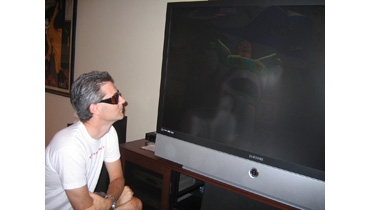We Give a Critical Eye to 'High Definition Glasses.' Page 3

I wasn't sure what to expect while watching actual HDTV while wearing the HD glasses. Would I see 1080 x 2? 1080 x 1080? Or perhaps 1080 raised to the power of 1080? What I did see was regular HD, just a lot darker and with that pinky-yellowy-brown color. Then I recalled that the owner's manual cautioned against wearing the glasses indoors - this would likely avoid just such an HD resolution conflict.
Walking outside, the world seemed far more three-dimensional. I know it's crazy, but things looked so real it felt like I could reach out and touch things I was seeing. Instead of passively looking through a clear window onto the world, I was in the world, experiencing the action. Shadow detail was amazing, with no irritating gradations in the gray scale. HDVision incorporates some edge-enhancement technology that is particularly useful while cloud gazing. Clouds that were invisible with the naked eye suddenly sprang to life, clearly defined against the blue sky. If cloud gazing is your thing, HDVision WrapArounds will make it better.
 |
| The standard HDVision WrapArounds (left) and the NightVision edition (right). |
Like you, when I hear the term "Night Vision," I think of Delta Force operators kicking in doors and taking out bad guys. Or green, blurry make-up sessions covertly captured on reality TV shows. Either way, "night vision" means seeing in the night, which is generally accepted to be dark. With the HDGlasses, Night Vision has a much looser interpretation. Putting on the bright yellow lenses immediately does two things. First, you look like classic '90s-era Bono. Second, things get brighter. Insanely brighter. Wearing them in normal lighting is actually painful on the eyes, making you want to instantly put the regular HDVision WrapArounds on top of them. They have a strong bias towards yellow, and resemble looking through a glass of bright, clear urine. When used in low IRE settings (around 20 to 40 IRE on the Grayscale), say driving in the rain or near dusk, they offer a lot of contrast and reveal low-level details that might otherwise be lost.
Audio performance was beyond reproach. Of course, the glasses have no sound producing abilities at all, so this was to be expected. The temples did fit snugly behind my ears, and didn't hinder my hearing.
BOTTOM LINE
HDVision WrapArounds won't be for everyone. Doubtless there will be cynics who will claim they've lived this long in standard def so why change now? I'm sure there were similar cries during the '60s when the switchover from black-and-white to color was happening.
However, for early adopters â€" and those looking to squeeze the last drop of performance out of life at any cost - HDVision WrapArounds offer an alternative to cool, designer shades. Once you've experienced HD, there's no going back.




























































